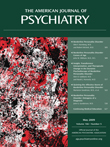Antidepressant Response Associated With Pioglitazone: Support for an Overlapping Pathophysiology Between Major Depression and Metabolic Syndrome
To The Editor: Metabolic syndrome independently contributes to the development of depressive symptoms (1) . Several lines of evidence suggest that depression may be mediated by the pathophysiology underlying metabolic syndrome, including hypothalamic-pituitary-adrenal axis dysregulation, insulin resistance, immunoinflammatory activation, and oxidative stress (2) . The thiazolidinedione class of antidiabetic drugs, through their neuroprotective, neurotrophic, insulin sensitizing, and anti-inflammatory effects, may be capable of altering these disturbances, leading to improved mood and enhanced cognition (3) . We report the case of a patient with treatment refractory major depressive disorder and co-occurring metabolic syndrome (as evidenced by hypertension, abdominal obesity, and impaired fasting glucose) who demonstrated a marked and sustained antidepressant response when pioglitazone was prescribed for depression augmentation.
“Ms. A” was a 55-year-old Caucasian female who experienced her first episode of depression at age 25 and was subsequently diagnosed with dysthymic disorder and recurrent major depressive disorder. She lived the majority of her adult life with chronic dysthymia interspersed with repeated, severe major depressive episodes, many requiring treatment with ECT. She had been experiencing a depressive recurrence lasting 6 months and was prescribed duloxetine (90 mg/day), lamotrigine (200 mg/day), trazodone (75 mg/day), and clonazepam (1 mg/day) in addition to individual and group psychotherapy. Augmentation with modafinil (100 mg/day), quetiapine (300 mg/day), and paliperidone (9 mg/day) were unsuccessful in alleviating her symptoms. Ms. A refused ECT, given subjective complaints of retrograde amnesia. During prior episodes, she had not responded to six antidepressant trials, four atypical antipsychotic trials, and augmentation with divalproex, liothyronine, and lithium. Her symptoms were very severe, as indicated by both the Quick Inventory of Depressive Symptoms—Self Report (score: 21) and Inventory of Depressive Symptoms—Clinician Rated (score: 48).
Prior to starting treatment with pioglitazone (15 mg/day), no changes had been made to the patient’s antidepressant medications or doses for 12 weeks. Within 2 weeks of receiving treatment with pioglitazone, she reported a moderate degree of symptom improvement. After 12 weeks of treatment (endpoint dose: 30 mg/day), she demonstrated a marked antidepressant response, with symptom severity falling to the mild range (Quick Inventory of Depressive Symptoms—Self Report score: 10; Inventory of Depressive Symptoms—Clinician Rated score: 20). The patient’s response has been sustained for 24 weeks, representing the longest period of relative wellness she has experienced over the last 13 years. Insulin resistance, as measured by the homeostatic model assessment, improved meaningfully from 5.88 to 2.56 (mmol/l × μU/ml). Marginal changes were observed in abdominal circumference, blood pressure, and lipids.
Limitations to the present case report include a sample size of one and the possibility that the patient’s improvement was secondary to a placebo effect, although this is unlikely given that ECT was needed to successfully treat previous episodes. Additionally, the lack of follow-up data beyond 24 weeks makes the association between pioglitazone and depression provisional.
1. Koponen H, Jokelainen J, Keinänen-Kiukaanniemi S, Kumpusalo E, Vanhala M: Metabolic syndrome predisposes to depressive symptoms: a population-based 7-year follow-up study. J Clin Psychiatry 2008; 69:178–182Google Scholar
2. Capuron L, Su S, Miller AH, Bremner JD, Goldberg J, Vogt GJ, Maisano C, Jones L, Murrah NV, Vaccarino V: Depressive symptoms and metabolic syndrome: Is inflammation the underlying link? Biol Psychiatry 2008; 64:896–900Google Scholar
3. McIntyre RS, Soczynska JK, Lewis GF, MacQueen GM, Konarski JZ, Kennedy SH: Managing psychiatric disorders with antidiabetic agents: translational research and treatment opportunities. Expert Opin Pharmacother 2006; 7:1305–1321Google Scholar



